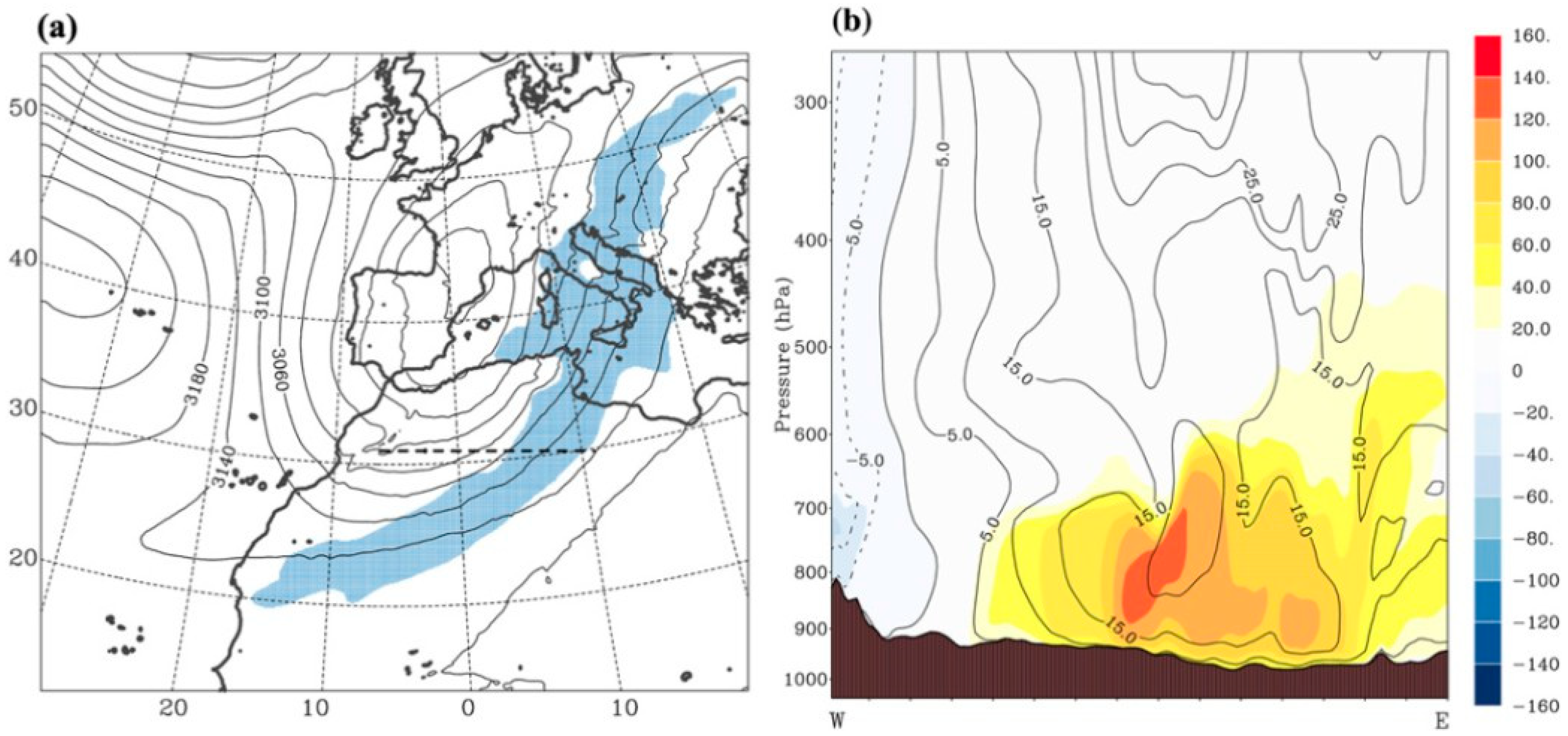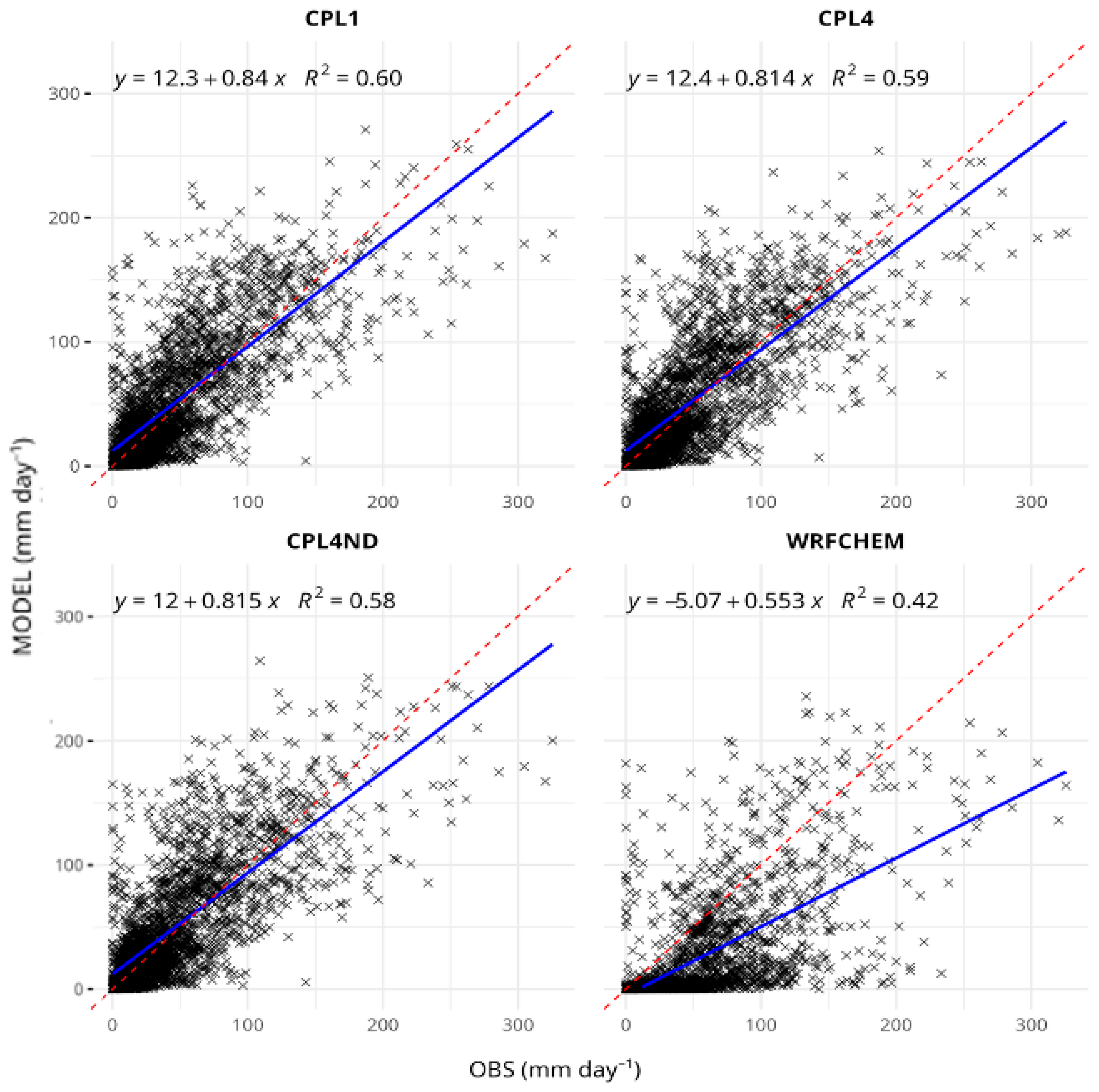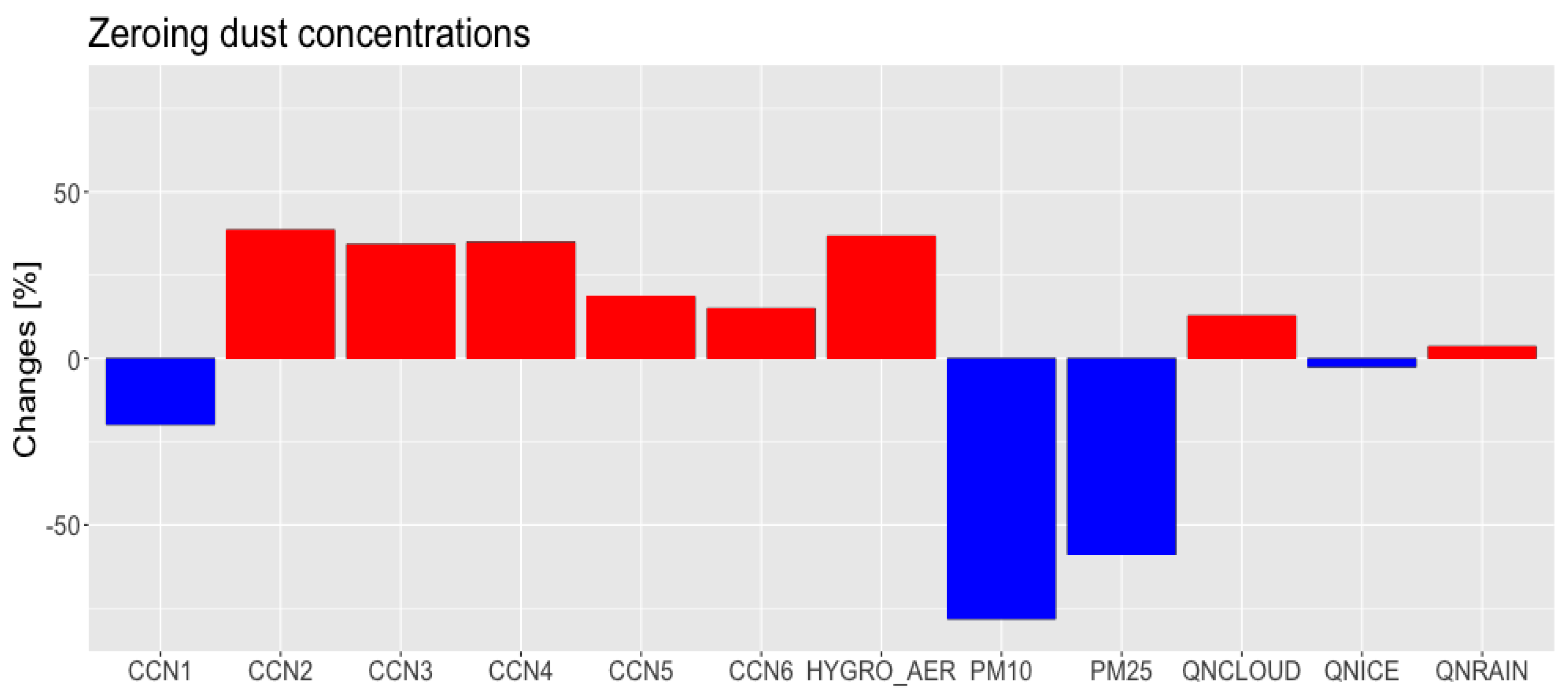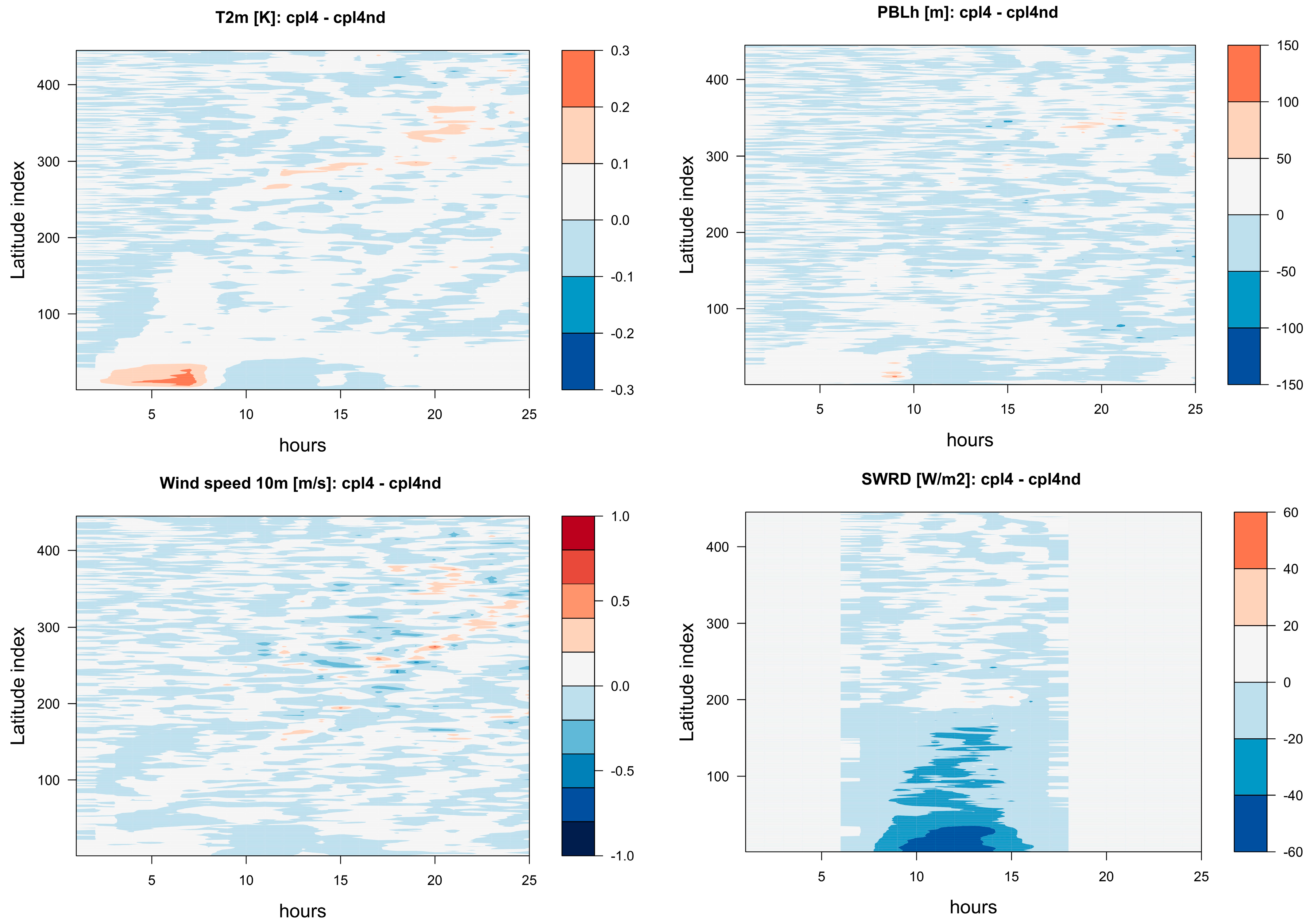Multi-Model Simulations of a Mediterranean Extreme Event: The Impact of Mineral Dust on the VAIA Storm
Abstract
:1. Introduction
2. Data and Methods
2.1. Description of Numerical Modeling
2.2. CHIMERE Model Fully Coupled with WRF
2.3. WRF-Chem Fully Coupled Online Model
3. Short Description of Observational Datasets
3.1. Moderate-Resolution Imaging Spectroradiometer Dataset
3.2. Spatial Interpolation Generator from Rainfall Observations
4. Synoptic Description by Modeling and Satellite Data
5. Modeling Results
WRF-CHIMERE Sensitivity Tests
6. Discussion
- Ensemble simulations with diverse aerosol schemes.
- Coupling with satellite assimilation products.
- Evaluating model performance across varied climatic and geographic settings.
7. Conclusions
- Both the WRF-CHIMERE and WRF-Chem models captured the overall precipitation patterns but significantly underestimated the 24 h rainfall at key locations (e.g., Malga Valine).
- Simulations without dust showed up to 78% lower PM10 and 59% lower PM2.5 mass concentrations, but increased CCN numbers for most supersaturation thresholds due to changes in aerosol hygroscopicity.
- Domain-averaged impacts on total precipitation and temperature were limited, suggesting that dust effects are highly localized and dependent on the orography and microphysics.
- WRF-Chem exhibited larger biases, pointing to the need for tuning the dust emission and aerosol coupling schemes.
- The results underscore the complexity and context-dependence of aerosol–cloud–precipitation interactions, warranting further multi-event and ensemble-based investigations.
Author Contributions
Funding
Data Availability Statement
Acknowledgments
Conflicts of Interest
References
- Andreae, M.; Rosenfeld, D. Aerosol–cloud–precipitation interactions. Part 1. The nature and sources of cloud-active aerosols. Earth-Sci. Rev. 2008, 89, 13–41. [Google Scholar] [CrossRef]
- Levy, H.; Horowitz, L.W.; Schwarzkopf, M.D.; Ming, Y.; Golaz, J.-C.; Naik, V.; Ramaswamy, V. The roles of aerosol direct and indirect effects in past and future climate change. J. Geophys. Res. Atmos. 2013, 118, 4521–4532. [Google Scholar] [CrossRef]
- Baklanov, A.; Brunner, D.; Carmichael, G.; Flemming, J.; Freitas, S.; Gauss, M.; Hov, Ø.; Mathur, R.; Schlu, K.H.; Seigneur, C.; et al. Key issues for seamless integrated chemistry–meteorology modeling. Bull. Am. Meteorol. Soc. 2017, 98, 2285–2292. [Google Scholar] [CrossRef] [PubMed]
- Raes, F.; Van Dingenen, R.; Vignati, E.; Wilson, J.; Putaud, J.-P.; Seinfeld, J.H.; Adams, P. Formation and cycling of aerosols in the global troposphere. Atmos. Environ. 2000, 34, 4215–4240. [Google Scholar] [CrossRef]
- Jacobson, M.Z. Global direct radiative forcing due to multicomponent anthropogenic and natural aerosols. J. Geophys. Res. Atmos. 2001, 106, 1551–1568. [Google Scholar] [CrossRef]
- Rosenfeld, D.; Andreae, M.O.; Asmi, A.; Chin, M.; de Leeuw, G.; Donovan, D.P.; Kahn, R.; Kinne, S.; Kiveka, N.; Kulmala, M.; et al. Global observations of aerosol-cloud-precipitation-climate interactions. Rev. Geophys. 2014, 52, 750–808. [Google Scholar] [CrossRef]
- Deroubaix, A.; Menut, L.; Flamant, C.; Knippertz, P.; Fink, A.H.; Batenburg, A.; Brito, J.; Denjean, C.; Dione, C.; Dupuy, R.; et al. Sensitivity of low-level clouds and precipitation to anthropogenic aerosol emission in southern west Africa: A dacciwa case study. Atmos. Chem. Phys. 2022, 22, 3251–3273. [Google Scholar] [CrossRef]
- Forkel, R.; Werhahn, J.; Hansen, A.B.; McKeen, S.; Peckham, S.; Grell, G.; Suppan, P. Effect of aerosol-radiation feedback on regional air quality—A case study with wrf/chem. Atmos. Environ. 2012, 53, 202–211. [Google Scholar] [CrossRef]
- Salah, Z.; Steiner, A.; Zakey, A.S.; Shalaby, A.; Wahab, M.A. An exploration of the aerosol indirect effects in east Asia using a regional climate model. Atmόsfera 2020, 33, 87–103. [Google Scholar] [CrossRef]
- Liu, X.; Easter, R.C.; Ghan, S.J.; Zaveri, R.; Rasch, P.; Shi, X.; Lamarque, J.-F.; Gettelman, A.; Morrison, H.; Vitt, F.; et al. Toward a minimal representation of aerosols in climate models: Description and evaluation in the community atmosphere model cam5. Geosci. Model Dev. 2012, 5, 709–739. [Google Scholar] [CrossRef]
- Twomey, S. Aerosols, clouds and radiation. Atmos. Environ. Part A Gen. Top. 1991, 25, 2435–2442. [Google Scholar] [CrossRef]
- Re, S.; Benedetti, A.; Bozzo, A.; Haiden, T.; Jones, L.; Razinger, M.; Flemming, J.; Engelen, R.; Peuch, V.; Thepaut, J. Feedbacks of dust and boundary layer meteorology during a dust storm in the eastern Mediterranean. Atmos. Chem. Phys. 2015, 15, 12909–12933. [Google Scholar]
- Galmarini, S.; Hogrefe, C.; Brunner, D.; Makar, P.; Baklanov, A. Special issue section evaluating coupled models (aqmeii p2) preface. Atmos. Environ. 2015, 115, 340–344. [Google Scholar] [CrossRef]
- Filonchyk, M.; Peterson, M.P.; Zhang, L.; Yan, H. An analysis of air pollution associated with the 2023 sand and dust storms over China: Aerosol properties and PM10 variability. Geosci. Front. 2024, 15, 101762. [Google Scholar] [CrossRef]
- Tiwari, S.; Kumar, H.; Singh, S.; Kumar, A. Current status of aerosol-cloud interactions and their impact over the Northern Indian Ocean: A comprehensive review. Atmos. Res. 2023, 283, 106555. [Google Scholar] [CrossRef]
- Zender, C.S.; Miller, R.; Tegen, I. Quantifying mineral dust mass budgets: Terminology, constraints, and current estimates. Eos. Trans. Am. Geophys. Union 2004, 85, 509–512. [Google Scholar] [CrossRef]
- Jacobson, M.Z.; Kaufman, Y.J. Wind reduction by aerosol particles. Geophys. Res. Lett. 2006, 33, L24814. [Google Scholar] [CrossRef]
- Miglietta, M.M. Mediterranean tropical-like cyclones (medicanes). Atmosphere 2019, 10, 206. [Google Scholar] [CrossRef]
- Varga, G. Changing nature of Saharan dust deposition in the Carpathian basin (central Europe): 40 years of identified north african dust events (1979–2018). Environ. Int. 2020, 139, 105712. [Google Scholar] [CrossRef]
- Menut, L.; Tuccella, P.; Flamant, C.; Deroubaix, A.; Gaetani, M. The role of aerosol–radiation–cloud interactions in linking anthropogenic pollution over southern west africa and dust emission over the sahara. Atmos. Chem. Phys. 2019, 19, 14657–14676. [Google Scholar] [CrossRef]
- Parajuli, S.P.; Stenchikov, G.L.; Ukhov, A.; Mostamandi, S.; Kucera, P.A.; Axisa, D.; Gustafson, W.I., Jr.; Zhu, Y. Effect of dust on rainfall over the red sea coast based on wrf-chem model simulations. Atmos. Chem. Phys. 2022, 22, 8659–8682. [Google Scholar] [CrossRef]
- Flaounas, E.; Davolio, S.; Raveh-Rubin, S.; Pantillon, F.; Miglietta, M.M.; Gaertner, M.A.; Hatzaki, M.; Homar, V.; Khodayar, S.; Korres, G.; et al. Mediterranean cyclones: Current knowledge and open questions on dynamics. prediction, climatology and impacts. Weather. Clim. Dyn. 2022, 3, 173–208. [Google Scholar] [CrossRef]
- DeMott, P.J.; Prenni, A.J.; McMeeking, G.R.; Sullivan, R.C.; Petters, M.D.; Tobo, Y.; Niemand, M.; Möhler, O.; Snider, J.R.; Wang, Z.; et al. Integrating laboratory and field data to quantify the immersion freezing ice nucleation activity of mineral dust particles. Atmos. Chem. Phys. 2015, 15, 393–409. [Google Scholar] [CrossRef]
- Fast, J.D.; Gustafson, W.I., Jr.; Easter, R.C.; Zaveri, R.A.; Barnard, J.C.; Chapman, E.G.; Grell, G.A.; Peckham, S.E. Evolution of ozone, particulates, and aerosol direct radiative forcing in the vicinity of Houston using a fully coupled meteorology-chemistry-aerosol model. J. Geophys. Res. Atmos. 2006, 111, D21305. [Google Scholar] [CrossRef]
- Briant, R.; Tuccella, P.; Deroubaix, A.; Khvorostyanov, D.; Menut, L.; Mailler, S.; Turquety, S. Aerosol–radiation interaction modelling using online coupling between the wrf 3.7.1 meteorological model and the chimere 2016 chemistry-transport model, through the oasis3-mct coupler. Geosci. Model Dev. 2017, 10, 927–944. [Google Scholar] [CrossRef]
- Tuccella, P.; Menut, L.; Briant, R.; Deroubaix, A.; Khvorostyanov, D.; Mailler, S.; Siour, G.; Turquety, S. Implementation of aerosol-cloud interaction within wrf-chimere online coupled model: Evaluation and investigation of the indirect radiative effect from anthropogenic emission reduction on the benelux union. Atmosphere 2019, 10, 20. [Google Scholar] [CrossRef]
- Menut, L.; Bessagnet, B.; Briant, R.; Cholakian, A.; Couvidat, F.; Mailler, S.; Pennel, R.; Siour, G.; Tuccella, P.; Turquety, S.; et al. The chimere v2020r1 online chemistry-transport model. Geosci. Model Dev. 2021, 14, 6781–6811. [Google Scholar] [CrossRef]
- Mailler, S.; Menut, L.; Khvorostyanov, D.; Valari, M.; Couvidat, F.; Siour, G.; Turquety, S.; Briant, R.; Tuccella, P.; Bessagnet, B.; et al. Chimere-2017: From urban to hemispheric chemistry-transport modeling. Geosci. Model Dev. 2017, 10, 2397–2423. [Google Scholar] [CrossRef]
- Craig, A.; Valcke, S.; Coquart, L. Development and performance of a new version of the oasis coupler, oasis3-mct 3.0. Geosci. Dev. 2017, 10, 3297–3308. [Google Scholar] [CrossRef]
- Iacono, M.J.; Delamere, J.S.; Mlawer, E.J.; Shephard, M.W.; Clough, S.A.; Collins, W.D. Radiative forcing by long-lived greenhouse gases: Calculations with the AER radiative transfer models. J. Geophys. Res. Atmos. 2008, 113, D13103. [Google Scholar] [CrossRef]
- Thompson, G.; Eidhammer, T. A study of aerosol impacts on clouds and precipitation development in a large winter cyclone. J. Atmos. Sci. 2014, 71, 3636–3658. [Google Scholar] [CrossRef]
- Abdul-Razzak, H.; Ghan, S.J. A parameterization of aerosol activation sectional representation. J. Geophys. Res. Atmos. 2002, 107, AAC 1-1–AAC 1-6. [Google Scholar] [CrossRef]
- Ghan, S.J.; Leung, L.R.; Easter, R.C.; Abdul-Razzak, H. Prediction of cloud droplet number in a general circulation model. J. Geophys. Res. Atmos. 1997, 102, 21777–21794. [Google Scholar] [CrossRef]
- Koop, T.; Luo, B.; Tsias, A.; Peter, T. Water activity as the determinant for homogeneous ice nucleation in aqueous solutions. Nature 2000, 406, 611–614. [Google Scholar] [CrossRef]
- Hong, S.-Y.; Noh, Y.; Dudhia, J. A new vertical diffusion package withan explicit treatment of entrainment processes. Mon. Weather Rev. 2006, 134, 2318–2341. [Google Scholar] [CrossRef]
- Chen, F.; Dudhia, J. Coupling an advanced land surface–hydrology model with the penn state–ncar mm5 modeling system. part I: Model implementation and sensitivity. Mon. Weather Rev. 2001, 129, 569–585. [Google Scholar] [CrossRef]
- Grell, G.A.; Freitas, S.R. A scale and aerosol aware stochastic convective parameterization for weather and air quality modeling. Atmos. Chem. Phys. 2014, 14, 5233–5250. [Google Scholar] [CrossRef]
- Derognat, C.; Beekmann, M.; Baeumle, M.; Martin, D.; Schmidt, H. Effect of biogenic volatile organic compound emissions on tropospheric chemistry during the atmospheric pollution over the paris area (esquif) campaign in the ile-de-france region. J. Geophys. Res. Atmos. 2003, 108, 8560. [Google Scholar] [CrossRef]
- Wild, O.; Zhu, X.; Prather, M.J. Fast-j: Accurate simulation of in and below-cloud photolysis in tropospheric chemical models. J. Atmos. Chem. 2000, 37, 245–282. [Google Scholar] [CrossRef]
- Bessagnet, B.; Hodzic, A.; Vautard, R.; Beekmann, M.; Cheinet, S.; Honoré, C.; Liousse, C.; Rouil, L. Aerosol modeling with chimere—Preliminary evaluation at the continental scale. Atmos. Environ. 2004, 38, 2803–2817. [Google Scholar] [CrossRef]
- Guenther, A.; Karl, T.; Harley, P.; Wiedinmyer, C.; Palmer, P.I.; Geron, C. Estimates of global terrestrial isoprene emissions using megan (model of emissions of gases and aerosols from nature). Atmos. Chem. Phys. 2006, 6, 3181–3210. [Google Scholar] [CrossRef]
- Menut, L.; Mailler, S.; Siour, G.; Bessagnet, B.; Turquety, S.; Rea, G.; Briant, R.; Mallet, M.; Sciare, J.; Formenti, P.; et al. Ozone and aerosol tropospheric concentrations variability analyzed using the adrimed measurements and the wrf and chimere models. Atmos. Chem. Phys. 2015, 15, 6159–6182. [Google Scholar] [CrossRef]
- Monahan, E.C. The ocean as a source of atmospheric particles. In The Role of Air-Sea Exchange in Geochemical Cycling; D. Reidel Publishing Company: Dordrecht, The Netherlands, 1986; pp. 129–163. [Google Scholar]
- Rizza, U.; Brega, E.; Caccamo, M.T.; Castorina, G.; Morichetti, M.; Munao, G.; Passerini, G.; Magazu, S. Analysis of the etna 2015 eruption using wrf–chem model and satellite observations. Atmosphere 2020, 11, 1168. [Google Scholar] [CrossRef]
- Niu, G.-Y.; Yang, Z.-L.; Mitchell, K.E.; Chen, F.; Ek, M.B.; Barlage, M.; Kumar, A.; Manning, K.; Niyogi, D.; Rosero, E.; et al. The community noah land surface model with multiparameterization options (noah-mp): 1. model description and evaluation with local-scale measurements. J. Geophys. Res. Atmos. 2011, 116, D12109. [Google Scholar] [CrossRef]
- Stauffer, D.R.; Seaman, N.L. Multiscale four-dimensional data assimilation. J. Appl. Meteorol. Climatol. 1994, 33, 416–434. [Google Scholar] [CrossRef]
- Ginoux, P.; Chin, M.; Tegen, I.; Prospero, J.M.; Holben, B.; Dubovik, O.; Lin, S.-J. Sources and distributions of dust aerosols simulated with the gocart model. J. Geophys. Res. Atmos. 2001, 106, 20255–20273. [Google Scholar] [CrossRef]
- Su, L.; Fung, J.C. Investigating the role of dust in ice nucleation within clouds and further effects on the regional weather system over east asia part 1: Model development and validation. Atmos. Chem. Phys. 2018, 18, 8707–8725. [Google Scholar] [CrossRef]
- LeGrand, S.L.; Polashenski, C.; Letcher, T.W.; Creighton, G.A.; Peckham, S.E.; Cetola, J.D. The afwa dust emission scheme for the gocart aerosol model in wrf-chem v3.8.1. Geosci. Model Dev. 2019, 12, 131–166. [Google Scholar] [CrossRef]
- Ukhov, A.; Ahmadov, R.; Grell, G.; Stenchikov, G. Improving dust simulations in wrf-chem v4.1.3 coupled with the gocart aerosol module. Geosci. Model Dev. 2020, 14, 473–493. [Google Scholar] [CrossRef]
- Rizza, U.; Kandler, K.; Eknayan, M.; Passerini, G.; Mancinelli, E.; Virgili, S.; Morichetti, M.; Nolle, M.; Eleftheriadis, K.; Vasilatou, V.; et al. Investigation of an intense dust outbreak in the mediterranean using xmed-dry network, multiplatform observations, and numerical modeling. Appl. Sci. 2021, 11, 1566. [Google Scholar] [CrossRef]
- Kaufman, Y.J.; Wald, A.E.; Remer, L.A.; Gao, B.-C.; Li, R.-R.; Flynn, L. The modis 2.1-/spl mu/m channel-correlation with visible reflectance for use in remote sensing of aerosol. IEEE Trans. Geosci. Remote Sens. 1997, 35, 1286–1298. [Google Scholar] [CrossRef]
- Hsu, N.; Jeong, M.-J.; Bettenhausen, C.; Sayer, A.; Hansell, R.; Seftor, C.; Huang, J.; Tsay, S.-C. Enhanced deep blue aerosol retrieval algorithm: The second generation. J. Geophys. Res. Atmos. 2013, 118, 9296–9315. [Google Scholar] [CrossRef]
- Remer, L.A.; Tanr, D.; Kaufman, Y.J.; Levy, R.; Mattoo, S. Algorithm for Remote Sensing of Tropospheric Aerosol from Modis: Collection 005; National Aeronautics and Space Administration: Washington, DC, USA, 2006. [Google Scholar]
- Davolio, S.; Della Fera, S.; Laviola, S.; Miglietta, M.M.; Levizzani, V. Heavy precipitation over Italy from the Mediterranean storm “Vaia” in October 2018: Assessing the role of an atmospheric river. Mon. Weather Rev. 2020, 148, 3571–3588. [Google Scholar] [CrossRef]
- European Commission. Commission Implementing Decision 2011/850/EU of 12 December 2011 laying down rules for the timing, format and submission of information by Member States pursuant to Directive 2007/2/EC of the European Parliament and of the Council on the spatial information infrastructure in the European Community (INSPIRE). Off. J. Eur. Union 2011, L335, 15–22. [Google Scholar]









| WRF-CHIEMERE Runs | |||
|---|---|---|---|
| Label | CPL1 | CPL4 | CPL4nd |
| Coupling | offline | online | online |
| Aerosols | all species | all species | all species without dust |
| CPL1 | CPL4 | CPL4nd | WRF-Chem | |
|---|---|---|---|---|
| MB | 5.01 | 3.88 | 3.56 | −25.22 |
| RMSE | 32.81 | 32.75 | 33.42 | 44.22 |
| MAE | 22.25 | 22.18 | 22.35 | 31.68 |
| R | 0.77 | 0.77 | 0.76 | 0.65 |
Disclaimer/Publisher’s Note: The statements, opinions and data contained in all publications are solely those of the individual author(s) and contributor(s) and not of MDPI and/or the editor(s). MDPI and/or the editor(s) disclaim responsibility for any injury to people or property resulting from any ideas, methods, instructions or products referred to in the content. |
© 2025 by the authors. Licensee MDPI, Basel, Switzerland. This article is an open access article distributed under the terms and conditions of the Creative Commons Attribution (CC BY) license (https://creativecommons.org/licenses/by/4.0/).
Share and Cite
Landi, T.C.; Tuccella, P.; Rizza, U.; Morichetti, M. Multi-Model Simulations of a Mediterranean Extreme Event: The Impact of Mineral Dust on the VAIA Storm. Atmosphere 2025, 16, 745. https://doi.org/10.3390/atmos16060745
Landi TC, Tuccella P, Rizza U, Morichetti M. Multi-Model Simulations of a Mediterranean Extreme Event: The Impact of Mineral Dust on the VAIA Storm. Atmosphere. 2025; 16(6):745. https://doi.org/10.3390/atmos16060745
Chicago/Turabian StyleLandi, Tony Christian, Paolo Tuccella, Umberto Rizza, and Mauro Morichetti. 2025. "Multi-Model Simulations of a Mediterranean Extreme Event: The Impact of Mineral Dust on the VAIA Storm" Atmosphere 16, no. 6: 745. https://doi.org/10.3390/atmos16060745
APA StyleLandi, T. C., Tuccella, P., Rizza, U., & Morichetti, M. (2025). Multi-Model Simulations of a Mediterranean Extreme Event: The Impact of Mineral Dust on the VAIA Storm. Atmosphere, 16(6), 745. https://doi.org/10.3390/atmos16060745







